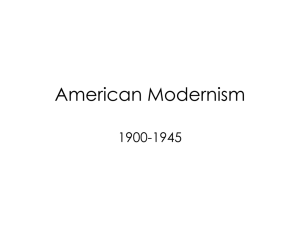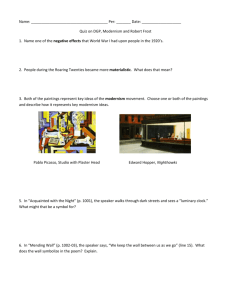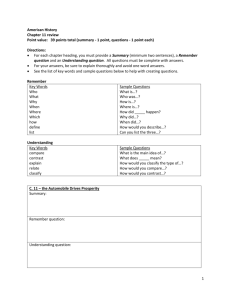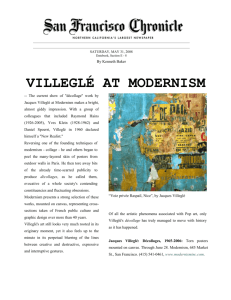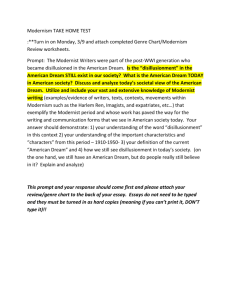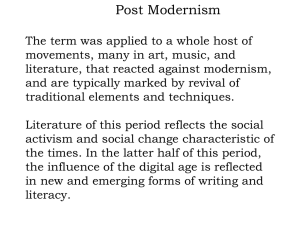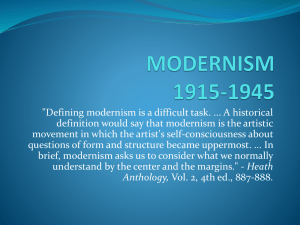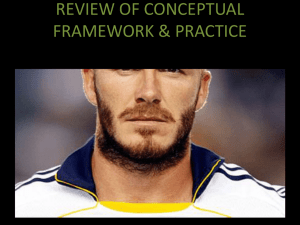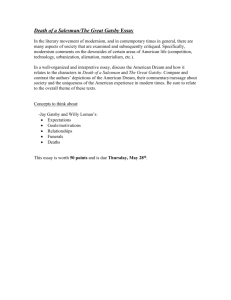American Modernism
advertisement
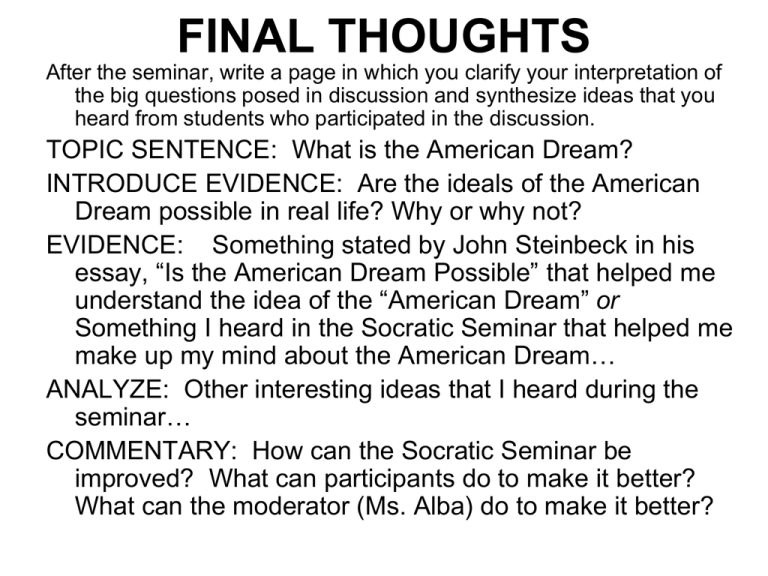
FINAL THOUGHTS After the seminar, write a page in which you clarify your interpretation of the big questions posed in discussion and synthesize ideas that you heard from students who participated in the discussion. TOPIC SENTENCE: What is the American Dream? INTRODUCE EVIDENCE: Are the ideals of the American Dream possible in real life? Why or why not? EVIDENCE: Something stated by John Steinbeck in his essay, “Is the American Dream Possible” that helped me understand the idea of the “American Dream” or Something I heard in the Socratic Seminar that helped me make up my mind about the American Dream… ANALYZE: Other interesting ideas that I heard during the seminar… COMMENTARY: How can the Socratic Seminar be improved? What can participants do to make it better? What can the moderator (Ms. Alba) do to make it better? American Modernism: Historical Context CCCS Focus Standard: RL 11-12. 9 Demonstrate knowledge of 18th, 19th, and early 20th Century foundational works of American literature including how two or more texts from the same period treat similar themes or topics. Objective: Identify the historical context of American Modernism and explain its effects on American thought, culture. AGENDA: 1. Socratic Seminar Debrief 2. Historical Context of American Modernism 3. Definition of American Modernism 4. 3-2-1 CHECK IN The American Dream 1. America as the New Eden: A land of beauty, bounty, and unlimited promise. 2. A belief in unlimited progress: life keeps getting better and we are always moving toward greater prosperity, justice and happiness. 3. Triumph of the individual: the independent, self-reliant person as the IDEAL American. How did Modernists view the American Dream? Modernism 1920’s Describe the historical context which inspired American Modernism A cultural and social movement that was caused by disillusionment with traditions. Modernism called for bold experimentation in style, subject matter, and attitude. Artists aimed to rid art of 19th Century Sentimentality and “prettiness.” Define American Modernism Why would there be a rise in Marxism and interest in the psychoanalysis or the inner workings of the mind? How did Jazz and the Harlem Renaissance breakdown gender roles and racial barriers? Why was the traditional “Hero” no longer an believable character in literature? Evaluate the effects of Modernism on American culture. Describe the historical context which inspired American Modernism by filling in the CIRCLE MAP as we watch “The Roaring 20’s”. 1920’s Define American Modernism •A cultural and social movement that was caused by disillusionment with traditions that reached its height between 1914-1939. •Modernism called for bold experimentation in style, subject matter, and attitude. •Artists aimed to rid art of 19th Century sentimentality and/or “prettiness.” “The Scream” by Edward Munch, 1893 Features of American Modernism Alienation Subversion of Cultural Norms and Traditions Subversion: is to rebel, overthrow, or undermine something. • • • • Women were given the right to vote in 1920. Hemlines raised; Margaret Sanger introduces the idea of birth control. Karl Marx’s ideas flourish; the Bolshevik Revolution overthrows Russia’s czarist government and establishes the Soviet Union. Writers begin to explore these new ideas. Alienation: the feeling of being turned away or rejected. Sense of alienation in literature: • • • The archetypal character belongs to what Gertrude Stein calls “lost generation” The antihero suffers from a “dissociation of sensibility”—separation of thought from feeling (T. S. Eliot) American Dream as “a Dream deferred” or unfulfilled (Langston Hughes). Valorization of the Antihero Antihero: A central character in a story, movie, or drama who lacks conventional heroic traits such as courage, physical or spiritual strength. • Antiheros in literature typically distrust conventional values and are unable to commit themselves to any ideals. • They generally feel helpless in a world over which they have no control. • The character traits of the antihero demonstrate the uncertainty felt by 3-2-1 Check OUT • 3 things you learned about Modernism and its historical context. • 2 things you want to learn more about. • 1 question about what we learned today.
